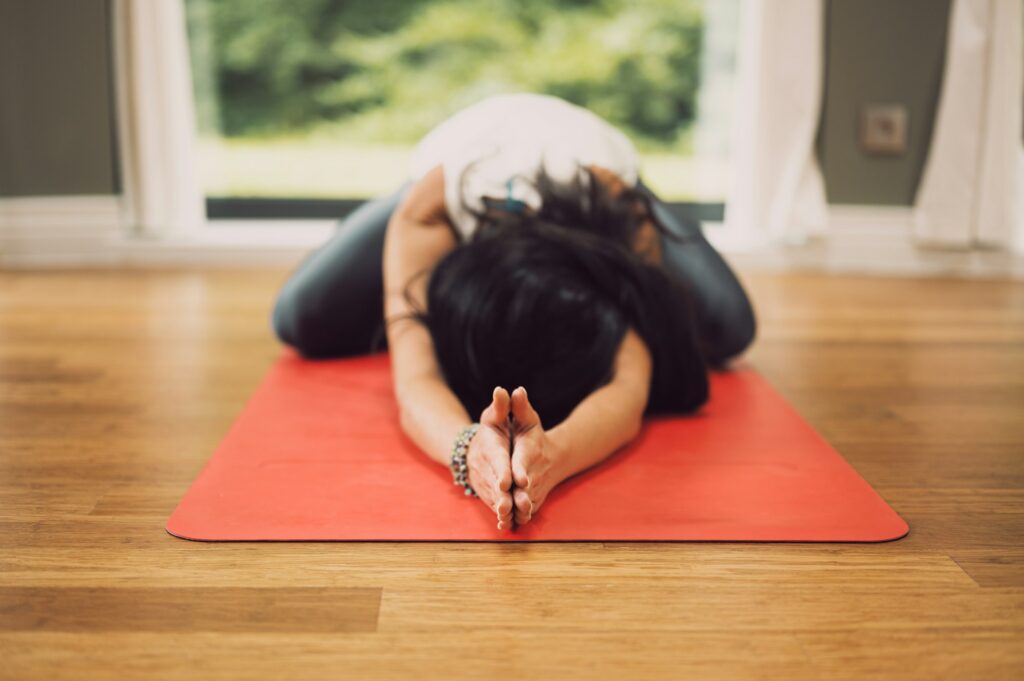
There’s a certain kind of stillness that (restorative yoga) cultivates. A stillness that wraps around you like a weighted blanket and unties the knots you never knew you had. In today’s world, where everything feels hurried and busy, this practice invites you just to be. With no agenda, no rush. It’s the perfect antidote for our sleep-deprived, anxious minds. But beyond rest, restorative yoga offers something deeper: a route to mental clarity as it reweaves the frayed edges of our thoughts.
Restorative yoga for better sleep and mental clarity is not a trend that’s here today and gone tomorrow, but an essential practice that brings balance to those moments when you feel the weight of the whole world pressing your shoulders. Here’s how it does that – and why you might need it now more than ever. But first – the basics!
What is restorative yoga?
Imagine lying in the most comfortable position: Your body melts into the floor, bolsters hug your sides, and a blanket drapes over you. In the simplest terms, that’s restorative yoga. It’s a practice of deep relaxation in which the body finds a passive way to heal, not through effort but by letting go.
A bit different than other types of yoga, restorative yoga doesn’t push or strain. Poses are held for five, ten, sometimes fifteen minutes – each stretching sequence opening like an orchid blooming in slow motion. You’re supported with props: blankets, blocks, bolsters. Anything that allows you to sink deeper into comfort.
Research, as mentioned in this 2019 paper from UNC (University of North Carolina), even suggests that restorative yoga enhances wellness by greatly reducing physical and mental stress. Therefore, there’s science behind that peace of body and mind you feel when you leave the mat.
Why is sleep so important (for mental clarity)?
Sleep, it turns out, might hold the main set of keys to unlocking mental clarity. You might think of sleep as a simple reset for the brain, but yes, it’s more than that. During those nightly hours, your brain does its thorough housekeeping – it sorts through memories, processes emotions, and clears out toxins that build up during the day. When this process is disrupted, the clarity of thought suffers; you wake up foggy, distracted, and struggling to make sense of the world around you. If sleep deprivation continues, the consequences are even more severe: anxiety, depression, and other long-term mental health challenges. That’s where restorative yoga enters the picture and becomes your life raft.
Your neurological system is where it all begins. The parasympathetic nervous system (PNS), the body’s rest-and-digest mode, can be triggered using restorative poses. Your breathing slows, your heart rate decreases, and your body signals to relax when this system is activated. The outcome? More restful, deeper sleep. And your brain clarity dramatically increases when you get better sleep.
Restorative yoga for better sleep and mental clarity
Props to the rescue
In restorative yoga, the props do the work. You’re not moving. You’re being held. There’s something comforting about how your body softens into the support of a bolster or the quiet warmth of a blanket draped over your legs. That allows every muscle to release its tension. As your physical self lets go, your mind will follow.
The art of deliberate laziness
It might seem counterintuitive to associate yoga with laziness, but restorative yoga for better sleep and mental clarity fully embraces this notion—what could be called intentional laziness. This paradox of “doing nothing yet doing everything” lies at the heart of the practice. In these moments, mental clarity isn’t some unattainable goal; instead, it naturally emerges when you allow yourself to simply be.
This deliberate stillness cultivates an effortless focus. The constant buzz of mental noise recedes, allowing the truly important thoughts to come into sharp relief. Restorative yoga provides this clarity and creates a fertile ground for self-reflection, creativity, and emotional balance.
Incorporating mindfulness techniques into restorative yoga can deepen its transformative effects. In truth, by practicing mindfulness to ease anxiety, you actively engage with the present moment, fostering a sense of calm and reducing stress. This synergy between mindfulness and yoga amplifies the benefits, offering a holistic approach to mental well-being. You may find that this combination helps regulate emotions, improves sleep, and enhances overall mental clarity over time.
In a world that constantly demands more, restorative yoga offers a powerful reminder: sometimes, doing less allows you to achieve more. It’s not just slowing down; it’s about tuning in and creating space for what truly matters.
Slo-mo savasana
Savasana – corpse pose – is the final pose in any yoga class, but in restorative yoga, it takes on new meaning. You stay here for what feels like forever, floating in that sweet spot between waking and sleeping. That isn’t the hurried savasana you’re used to at the end of a workout; this is the practice itself. You’re in it, fully committed to doing nothing. And it’s here, in the deep rest of savasana, that sleep and clarity meet.
Twisting out the tension
Twists are frequently used in restorative yoga poses for a reason. Like gently squeezing water out of a sponge, they release stress that you were unaware you were harboring.
As you twist, you release physical tension in your spine and back, but the mental release is even more profound. It’s almost as if, with each breath, you’re untwisting your thoughts.
An invitation to silence
Restorative yoga is, at its heart, an invitation to silence. As sound can heal, so can its absence. In this silence, mental clarity doesn’t need to be forced. The slower you move, the more your thoughts seem to slow down with you. The quieter your body becomes, the more peaceful your mind is.
There’s a sacredness to this kind of stillness that allows sleep to rise naturally, like a tide. Restorative yoga permits you to stop and rest deeply, offering a path to clarity that feels earned, though you didn’t have to work for it at all.
Conclusion
Restorative yoga for better sleep and mental clarity doesn’t require working harder. It’s about softening into what you already know. The world will keep turning, but for a while, you can step out of its spin into a space where rest is sacred, and clarity comes from sweet surrender.
In the quiet pauses, it’s here that your mind finds the stillness it needs, and sleep returns – like an old friend, ready to sit beside you again.
